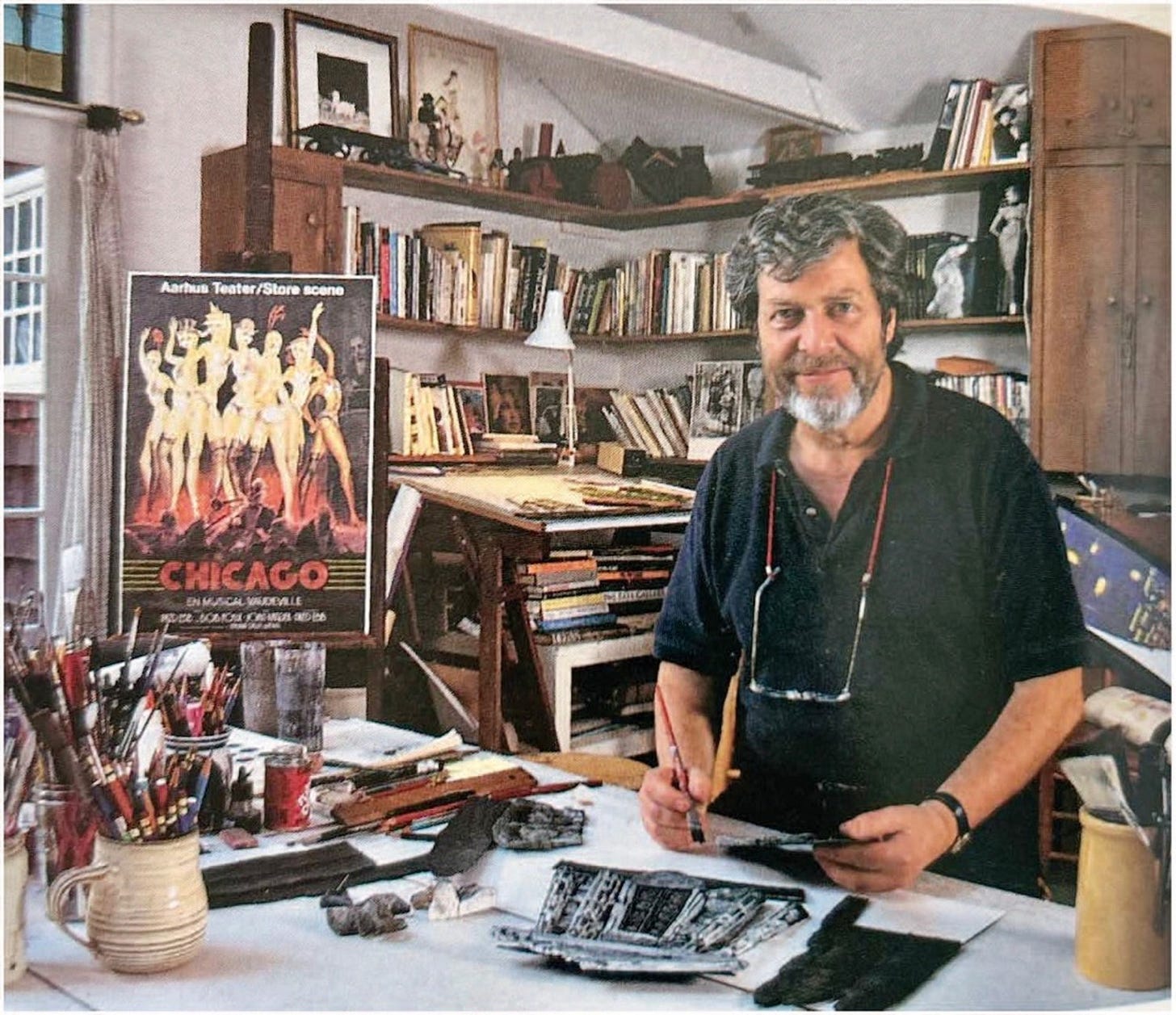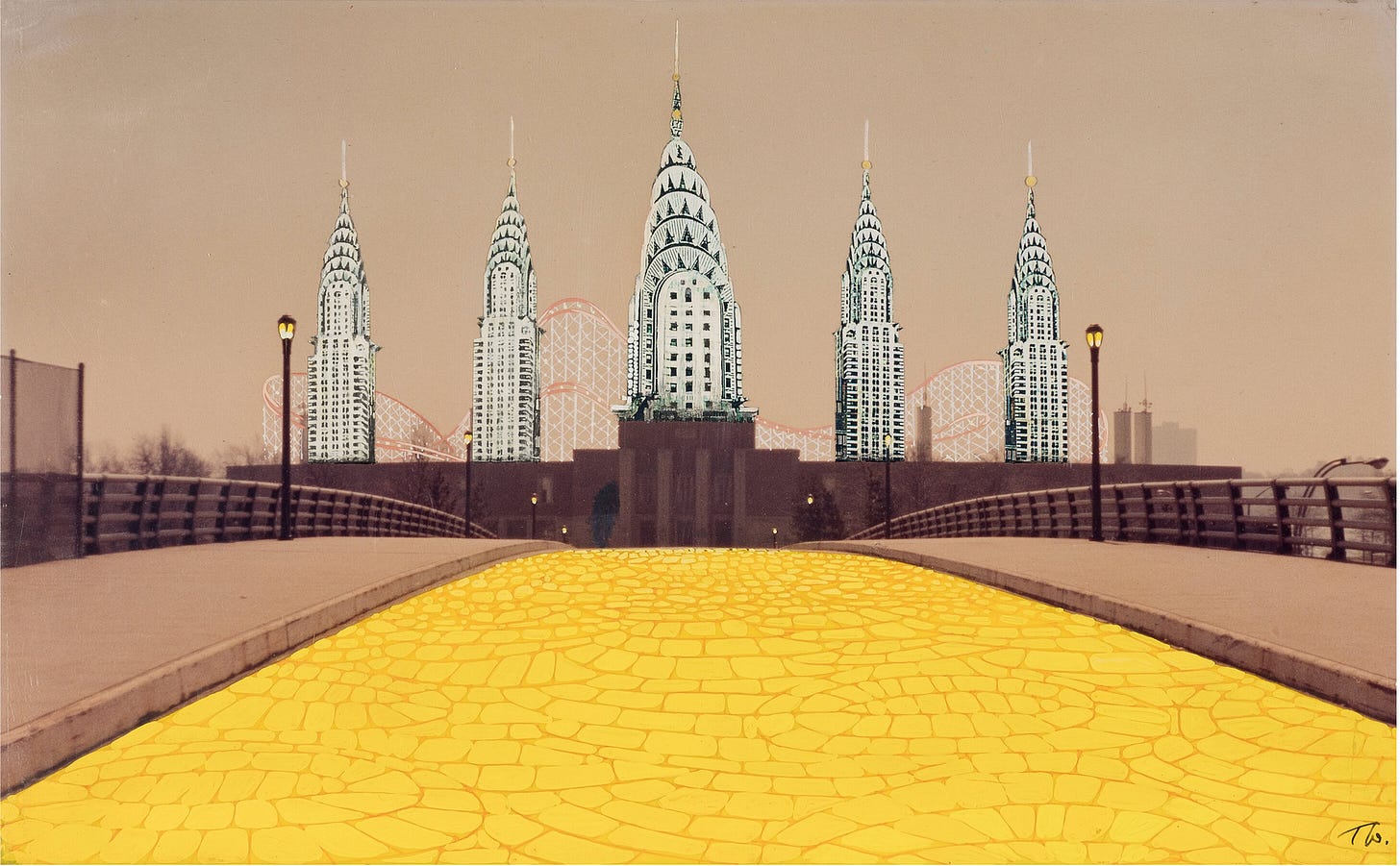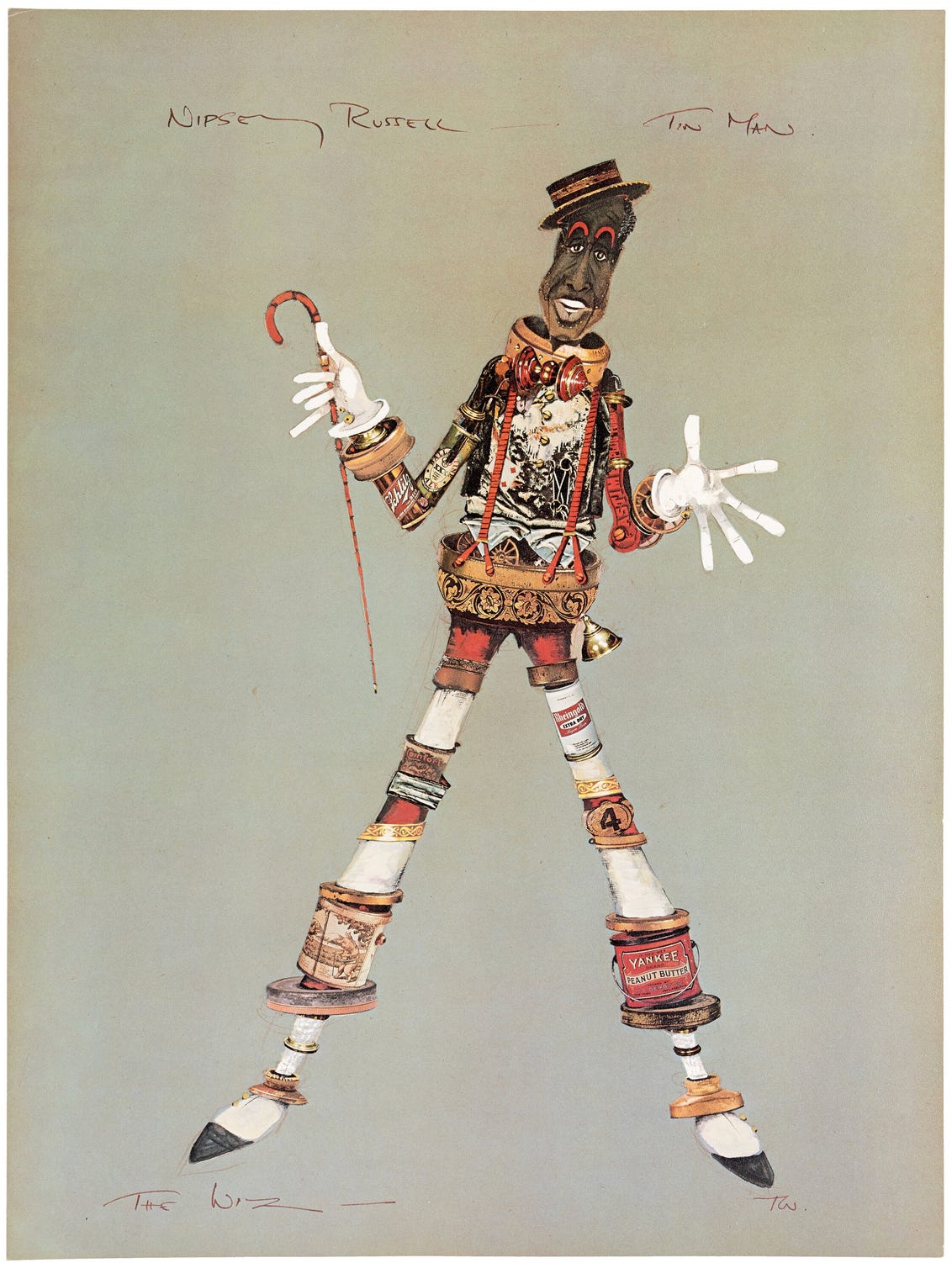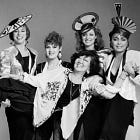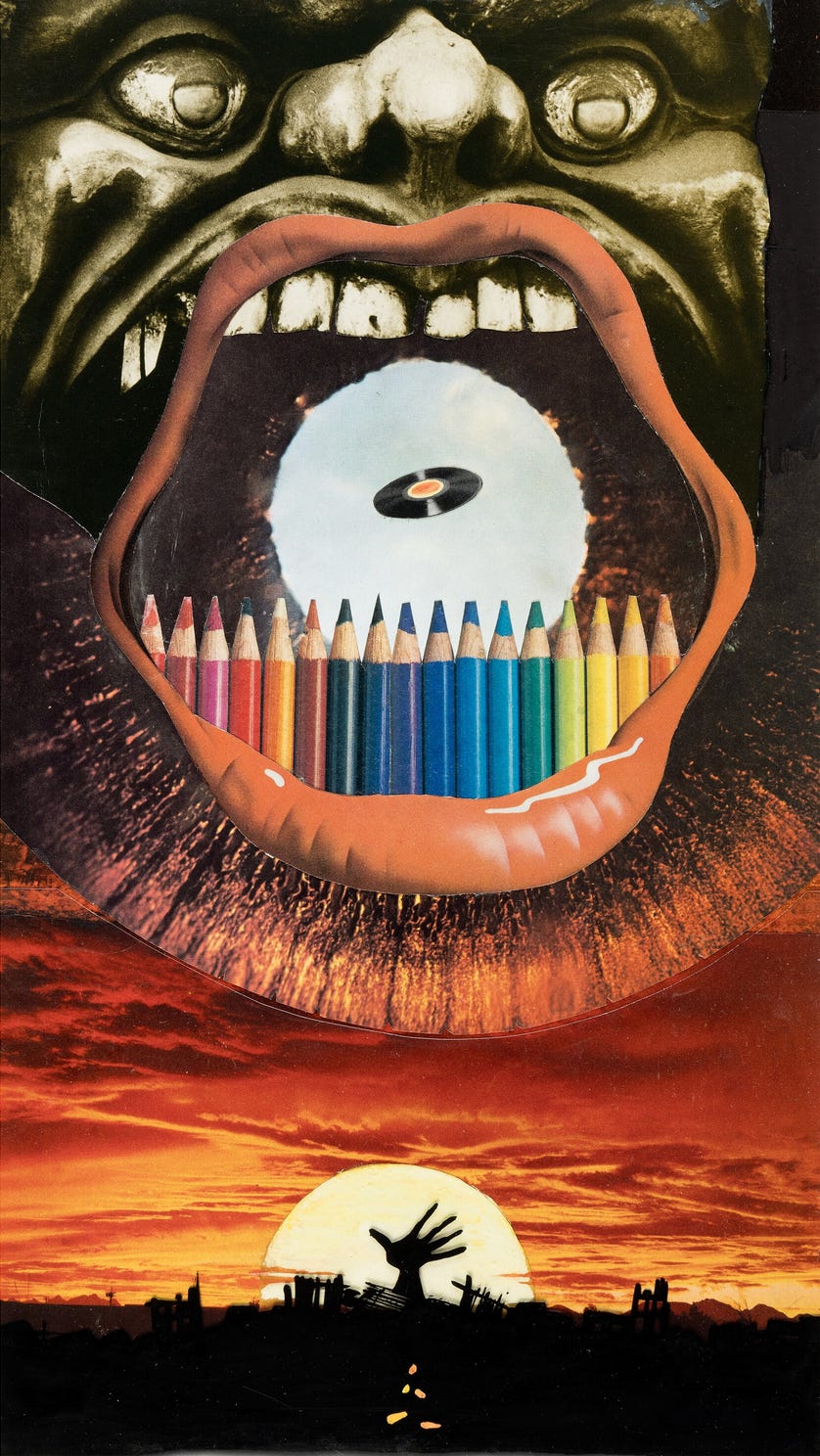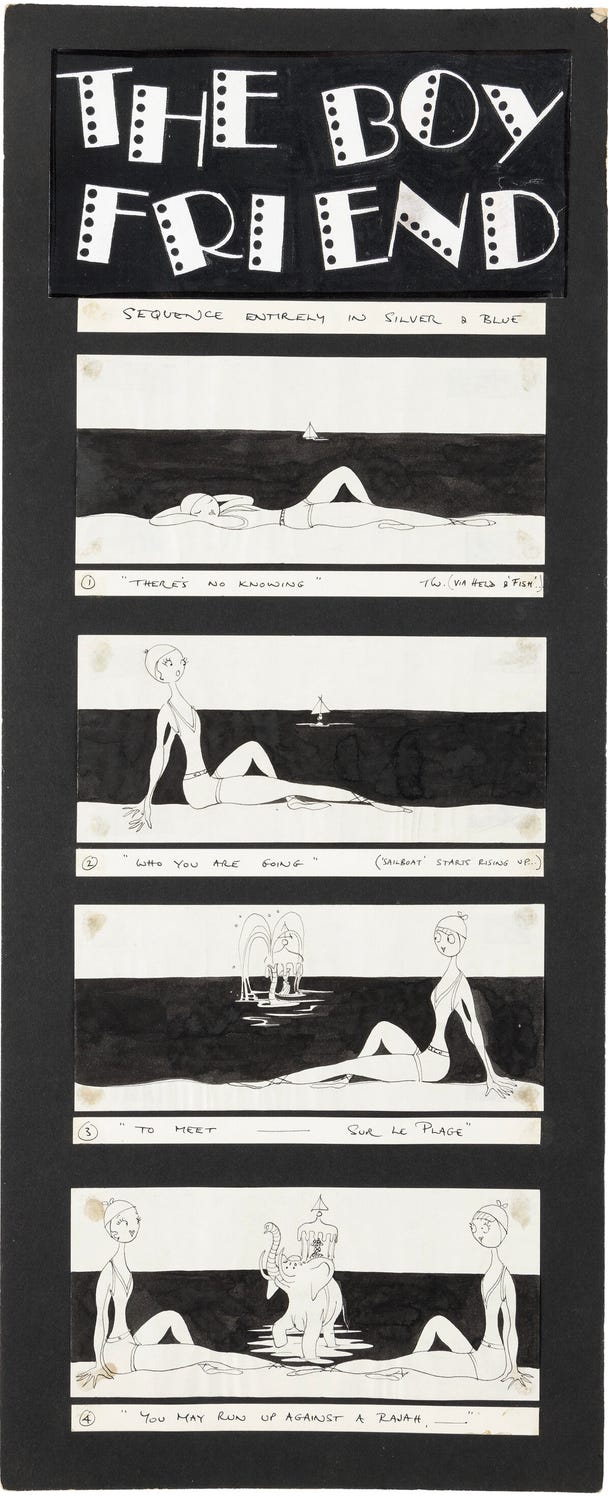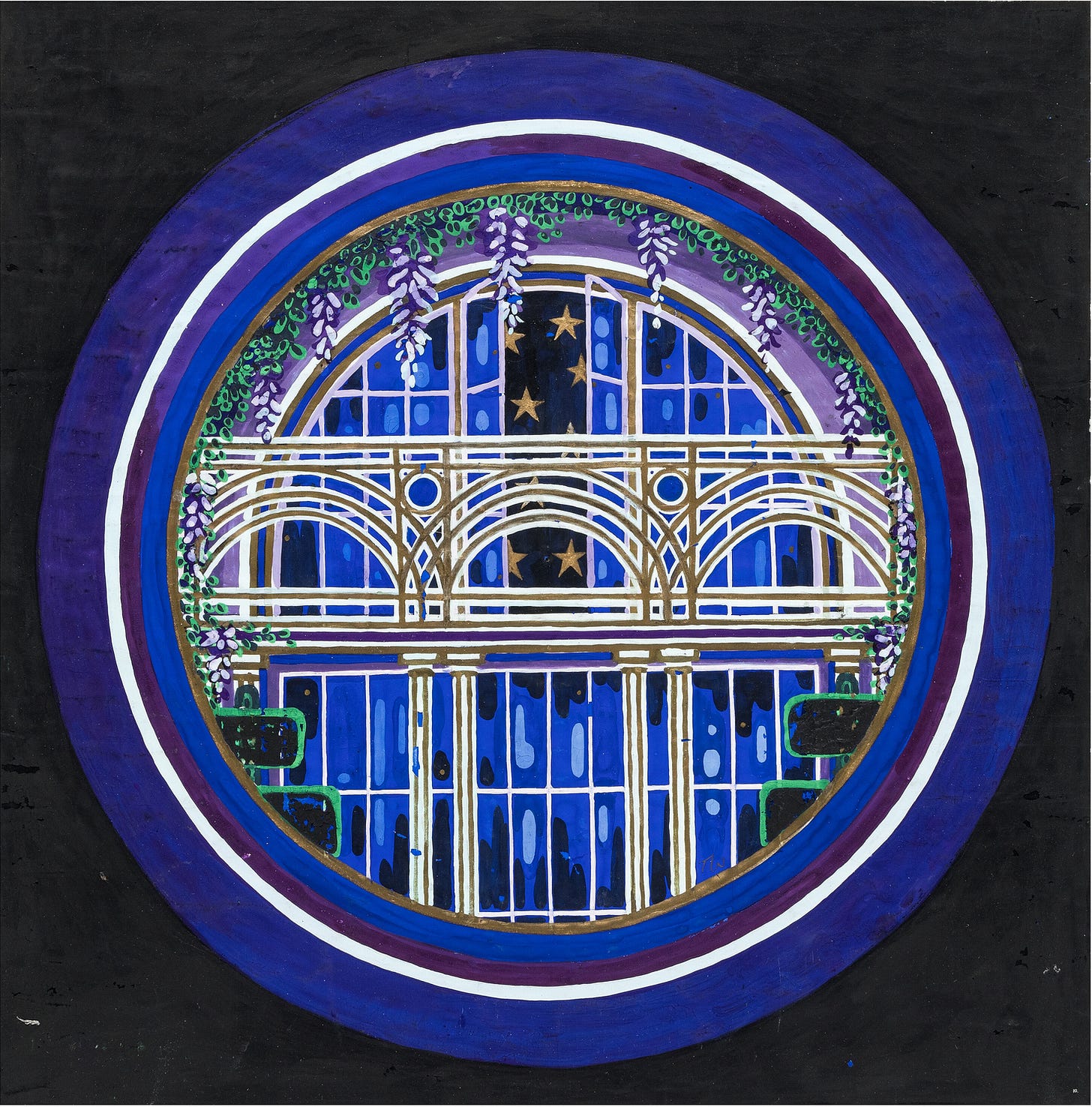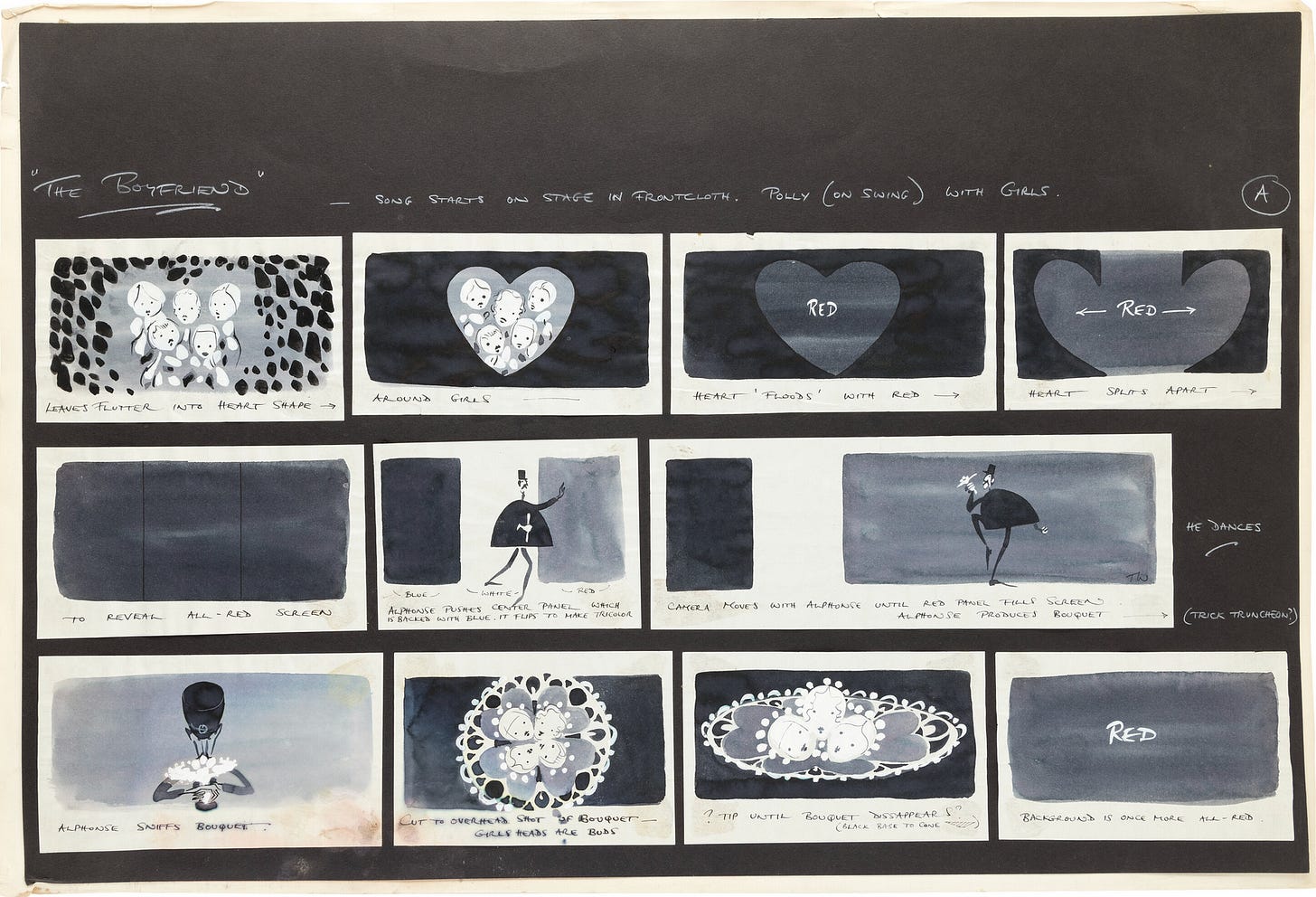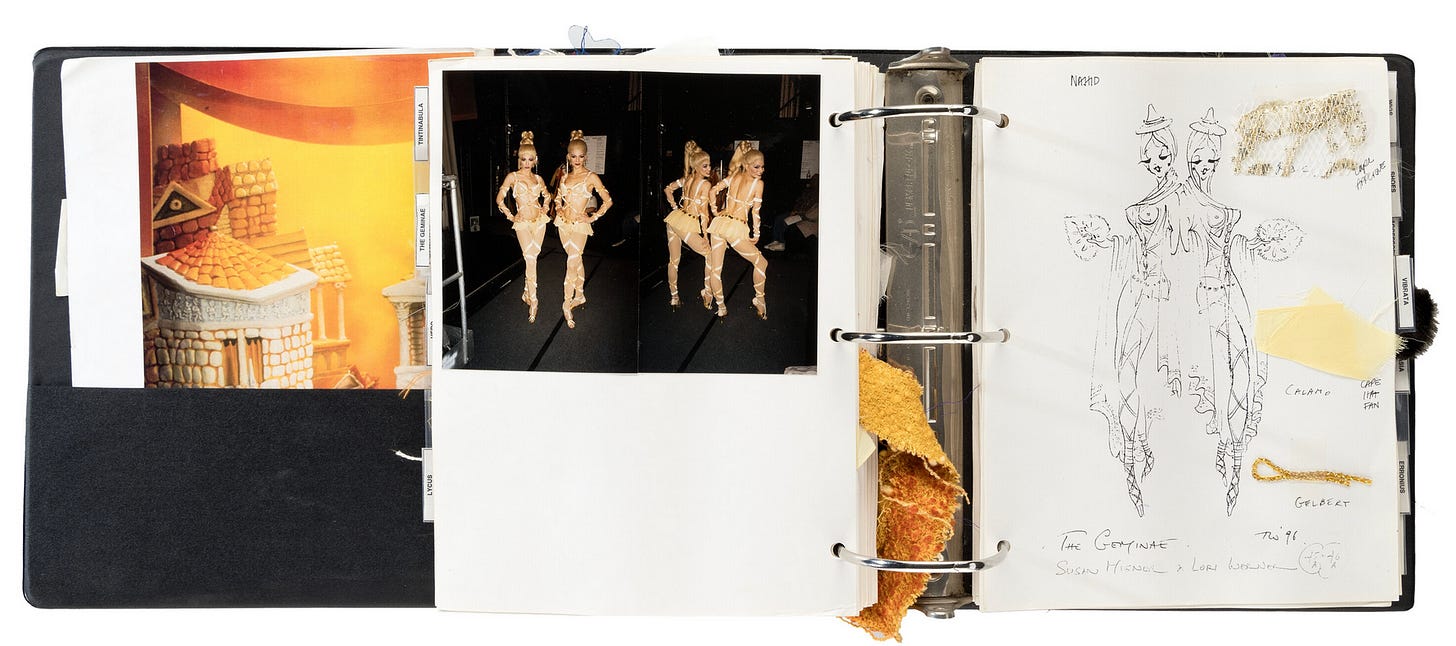With the news so depressing and overwhelming, I’ve been taking the few moments I can (while also caring for a one-year-old) to revel in art and think about the creative process. On Friday, May 16th, Heritage Auction auctioned works by the production and costume designer Tony Walton, who passed away in 2022 at age 87. These works—from rough sketches to hand-painted maquettes, costume illustrations with fabric scraps to dioramas—vividly bring to life his creative process of fabricating worlds for screen and stage.
While his career started designing for the stage in London, Walton got his big break when his first wife, Julie Andrews (they were childhood sweethearts), introduced him to Walt Disney when she signed on to do Mary Poppins; Disney offered to look at Walton’s portfolio, then hired him as a costume designer, set designer, and visual consultant for the film. It was Walton who was responsible for transposing the story to the Edwardian era (the original book was set in the 1930s) and who created the “simplified, almost cartoonlike re-creation of Edwardian London, with broad detail and bold colors nearly as artificial looking as the animated passages.” He received his first Academy Award nomination for Costume Design but lost to Cecil Beaton and My Fair Lady. Several of his costume and set designs for Mary Poppins are included among the auction lots.
Walton went on to work on fifteen more films and many more theatrical productions, usually taking on both costumes and sets—a rarity in a world where these jobs are usually separated, but which allowed him the space to create a total, all-encompassing vision for projects as diverse as the original stage production of Chicago (1975) and the film Murder on the Orient Express (1974), for which he received his second Academy Award nomination. A production designer, in the words of journalist Mason Wiley, “executes and interprets the director's visual concepts through his choice of sets and locales. The best production designers overcome a tricky paradox: maintaining their unique styles while assisting directors of all philosophies and personalities in realizing their most accomplished films.” Walton was one of the best, more than holding his own while working with directors as diverse as Ken Russell (The Boy Friend), Francois Truffaut (Fahrenheit 451), Bob Fosse (All That Jazz and Star 80, as well as the Stage production of Pippin), Richard Lester (A Funny Thing Happened on the Way to the Forum and Petulia), Mike Nichols (Heartburn and Regarding Henry), Paul Newman (The Glass Menagerie), and Sidney Lumet (The Sea Gull, Murder on the Orient Express, Equus, Just Tell Me What You Want, Prince of the City, and Deathtrap).
“My father was a man of the arts in every sense of the word. He ate, slept and breathed theater and film. Early in his career, he made a promise never to repeat himself… instead, he found a unique vision for each project that best served the piece itself.” - Emma Walton Hamilton
Where he excelled—where his understanding of how to create a totalizing vision shone best—was in musicals. Watching The Wiz or (my favourite) The Boy Friend, one is immersed in his genius—a collaborative yet singular genius, one that was unrivaled in creating worlds (both realistic and fantastical) that allowed fellow geniuses (from actors to directors and cinematographers) to shine. He worked from home, hand-painting maquettes and building wall-size color breakdowns for each scene, as well as making “models for every show he ever did, scale models that were like little doll houses, where you could see all the details in three dimensions, in such a way that designers seldom do today.”

To get an understanding of the depth of research Walton put into his work, here is a quote from an article he wrote for American Cinematographer (November 1978) on the making of The Wiz, which placed the fantasy of The Wizard of Oz within gritty New York City:
“In seeking a visual style for the film, we looked quite a lot at the work of black painters, particularly Romare Bearden, a contemporary artist who works a lot in collage, combining photographic elements with some high-key colored papers. Although there is really nothing that you could point to in the film and see as relating to his work, it was enormously helpful as a kind of motive force and a means of combining brightly colored fantasies with realistic textures. We also looked at the work of some slightly more primitive black painters—Horace Pippin, Jacob Lawrence and other New York artists—and there were things that erupted from their work. Some of the rooftop stuff, I think, probably stems from Ben Shahn's work. Our fantasized Yellow Cabs were probably triggered by Steinberg's early Yellow Cabs.”
While not all his movie and theatre productions are represented in the auction, among the lots are examples of his work beyond those worlds, including costumes for Bette Midler’s “Clams on the Half Shell Revue” and neon designs and other artwork for Studio 54 (among them the neon “Roxie” fan from Chicago that he repurposed).

As his daughter remembers, “At a certain point, he realized that he could quite easily develop a style gimmick that was popular and successful and that he could just keep repeating. Instead, he would only ever take jobs that would stretch him and invite him to try something new or different, or allow him to explore something he hadn’t tried before.” With curating the auction, “It really came home how successful he had been in that endeavor,” she continued, “because the breadth of the work, in terms of the variety of styles and approaches and materials, it’s extraordinary.”
Walton won his sole Oscar as part of the production team on All That Jazz, for which he was credited as “Fantasy Designer,” charged with fabricating hypnagogic hallucinations. He was nominated for sixteen Tony Awards, winning three times (for Best Scenic Design for Pippin, The House of Blue Leaves, and Guys and Dolls); he also won the Emmy for Outstanding Art Direction for a Miniseries or Movie for Death of a Salesman in 1985.
Below is a selection from the auction, lifting the curtain on his process and creativity, hopefully providing a little creative inspiration.
All That Jazz (TCF, 1979), Group of (8) Roy Scheider "Joe Gideon" Theater and Film Poster Artworks.
Original group of (8) poster artworks by Tony Walton rendered in photo collage and mixed media measuring 14" x 22". The pieces were created to showcase the fictional productions associated with protagonist Joe Gideon (Roy Scheider).
Sold for $18,125
The Wiz (Universal, 1978), Yellow Brick Road/Chrysler Building Concept Art.
Original concept artwork by Tony Walton rendered in paint and photography/mixed media collage on foam core measuring 19.25" x 12.75".
Sold for $12,500
Bette Midler's Clams on the Half Shell Revue (Theater Production, 1975), Group of (2) Portfolios with Costume and Scenic Design Artwork.
Original group of (2) portfolios containing costume and scenic design artwork created by Tony Walton for the classic Bette Midler revue. Collection includes (1) costume portfolio with (7) original costume sketches rendered in acrylic, crayon, and mixed media framed in a black matte measuring 13.5" x 18" and featuring the artist's original annotations and fabric swatches and (1) scenic design portfolio with preliminary sketches, designs for set elements (including the iconic Empire State Building art with King Kong), and extensive research materials.
Sold for $8,125
The Boy Friend Movie (MGM, 1971), Group of (6) "Poor Little Pierrette" Mixed Media Illustrations.
Original group of (6) cloth/mixed media set illustrations created by Tony Walton for the "Poor Little Pierrette" sequence in The Boy Friend. Collection includes (5) artworks on a black matte measuring from 9.75" x 13.75" to 17.25" x 13.5" and (1) artwork on a white matte (with two designs) measuring 20.5" x 23.75".
Sold for $2,750
Fahrenheit 451 (Rank Film Distributors, 1966), Portfolio with 40+ Set and Costume Sketches, Color Guides, and Storyboards.
Original portfolio measuring 26.5" x 20" containing Tony Walton's artwork and research materials for Fahrenheit 451.
Sold for $1,375
The Wiz Movie (Universal, 1978), Group of (2) Portfolios with Costume Lithographs and Art Prints.
Original group of (2) portfolios measuring 26.5" x 20.5" and containing costume lithographs and art prints created by Tony Walton. Collection highlights (14) costume lithographs measuring 18" x 24", including (2) Dorothy (Diana Ross), (4) Scarecrow (Michael Jackson), (2) Tin Man (Nipsey Russell), (2) Cowardly Lion (Ted Ross), (2) The Wiz (Richard Pryor), and (2) Evillene (Mabel King).
Sold for $9,375
A Funny Thing Happened on the Way to the Forum (Theater Production, 1962), Set Model.
Original set model crafted from balsa wood, cardboard, and mixed media measuring 24.75" x 17.5" x 20".
Sold for $5,750
The Boy Friend Movie (MGM, 1971), Group of (2) "Rainbow Airplane" Concept Artworks.
Original group of (2) concept artworks by Tony Walton rendered in watercolor, ink, glitter, and mixed media including (1) Glitter Rainbow Airplane artwork measuring 12.75" x 9.75" and (1) Watercolor Rainbow Airplane artwork measuring 11.5 x 10".
Sold for $625
Sophisticated Ladies (Theater Production, 1981), Original Poster Artwork.
Original artwork rendered in acrylic and pencil and mounted on foam core measuring 18.75" x 28.5".
Sold for $13,750
For more on the costumes in Sophisticated Ladies:
Studio 54 (Venue, 1977 - 1980), Group of (3) Portfolios Containing 30+ Wall Hangings, Mini Drops, and Assorted Interior Design Art.
Original group of (3) portfolios measuring from 20" x 15" to 36.5" x 25" and containing 30+ artworks by Tony Walton. From April 1977 to February 1980, the award-winning artist (along with Mark Ravitz and Aerographics) would contribute new and repurposed designs for the dance floor and the club's famous one-night-only events.
Sold for $656.25
These collages remind me of Penny Slinger’s works for the book Mountain Ecstacy (1978).
The Wiz (Universal, 1978), Float Model with (24) Figurines and Design Photos.
Original "Ease on Down the Road" float model constructed from wood, paper, and metal components measuring 8" x 22.5" x 6" (in height). Walton's two-level float design incorporates the yellow brick road bridge and Chrysler Building motifs seen during the Scarecrow (Michael Jackson) and Dorothy's (Diana Ross) discovery of the golden pathway.
Sold for $8,125
The Boy Friend Movie (MGM, 1971), Group of (5) Portfolios with Original Concept and Design Art and Research Notes.
Original group of (5) portfolios measuring from 26.5" x 20" to 36.25" x 24" containing dozens of original production designs, storyboards, sketches, and research notes.
Sold for $1,000
The Wiz (Universal, 1978), Yellow Brick Road/Brooklyn Bridge Concept Art.
Original concept artwork by Tony Walton rendered in paint and photography/mixed media collage on foam core measuring 23.5" x 10.5".
Sold for $10,000
Guys and Dolls (Theater Production, 1992), Portfolio with Original Scenic Design Paintings.
Original portfolio measuring 31" x 32.25" and containing 25+ scenic design artworks created by Tony Walton for the acclaimed revival.
Sold for $2,000
A Funny Thing Happened on the Way to the Forum (Theater Production, 1996), Group of (3) Costume Bibles.
Original group of (3) binders consisting of Tony Walton's extensive costume design documentation for the Tony-winning revival.
Sold for $937.50
The Wondrous Willa Kim
Last week the New York Public Library for the Performing Arts opened the first-ever major retrospective exhibition on the Korean-American costume designer Willa Kim. Kim, who passed away at age 99 in 2016, was the recipient of two Tony Awards for Best Costume Design (for
The Fantastic Tosi
We’ve likely all been captivated and entranced by Piero Tosi’s costumes. From his first film credit as costume designer—on Luchino Visconti’s Bellissima in 1951—he went on to work with most of the greats of Italian cinema: Vittorio De Sica, Federico Fellini, Pier Paolo Pasolini, Liliana Cavani, Franco Zefferelli, in addition to ten films with Visconti. Described by Hamish Bowles as “an alchemical genius whose fetishistic attention to period detail was matched by the perfectionism of the great directors with whom he collaborated,” Tosi was a great artist whose career spanned seven decades.




